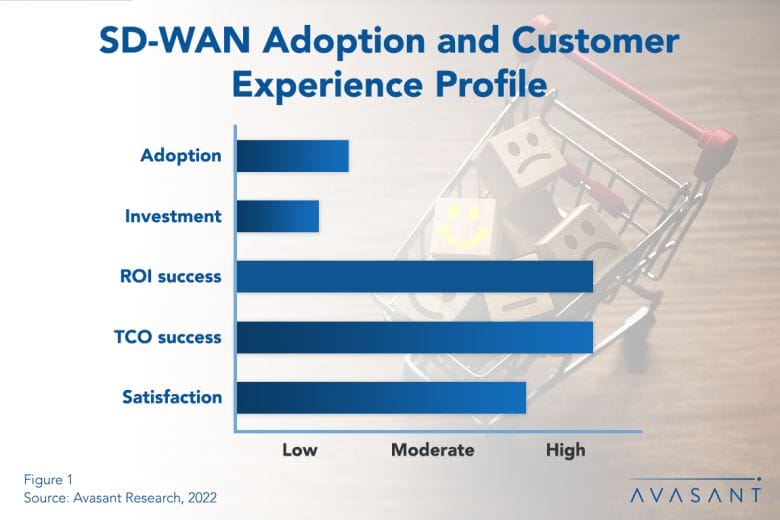The network serves as the backbone for the success of any digital transformation strategy. Incorporating SD-WAN as part of an organization’s digital strategy will improve the agility and flexibility of the network. Cloud, AI and anlytics tools, and automation are more accessible and integrated when the entire network is virtualized. Despite slow adoption so far, we believe that organizations need to invest in SD-WAN if they are serious about digital transformation.
As seen in Figure 1 from our full report, SD-WAN Adoption Trends and Customer Experience, the adoption and investment rates for SD-WAN are low. However, early adopters have reported high satisfication and even higher ROI and TCO success rates. We suspect that adoption is likely being held back because the new skill sets required to implement the technology are currently in short supply.

SD-WAN is the use of software-defined networking to establish and operate a wide-area network by virtualizing network resources. SD-WAN has evolved from a technology designed to reduce costs and enhance operational efficiency to being a crucial element in business sustainability, which was compounded by the COVID-19 pandemic and subsequent recession. SD-WAN is now becoming a necessary pillar for business and digital transformation.
Despite the positive economic characteristics of SD-WAN, our survey has highlighted that adoption and investment rates are low. While the technology provides flexibility, agility, easy configuration, and quick responses in volatile environments, there is a significant implementation cost. Businesses often need to make considerable capital costs to transition from traditional network technologies to SD-WAN. Moreover, if SD-WAN is implemented, employers will likely have to retrain support personnel for SD-WAN specific skills or search a tight labor market for the right talent. Either way, this initial investment in skills or the right equipment may be slowing adoption.
As noted, our research shows that early adopters and investors are seeing high ROI and TCO success rates. Most platforms now have AI and automation capabilities. SD-WAN rapidly reduces costs by displacing costly MPLS circuits, automating software upgrades, policy implementation, and routing traffic of the overlay/underlay network. Major technology services are incorporating AI Ops services that support analytics and AI to improve traffic management for SD-WAN architecture and services. These tasks go beyond scripting to incorporate analytics, pattern recognition, and AI in order to improve service quality.
“The economics of SD-WAN are simply too strong for adoption to remain low for much longer,” said Avasant Director Mark Gaffney, who specilizes in networks, IT management, and governance. “It is a solid investment in terms of cost savings and improving agility and flexibility in the network.”
Our full report quantifies the current adoption and investment trends for SD-WAN technology, as well as the benefits driving companies to expand their SD-WAN implementations. We assess these trends by organization size, sector, and geography and look at the ROI and TCO experiences of organizations that have adopted SD-WAN. We conclude with practical advice for those planning new investments in SD-WAN.
This Research Byte is a brief overview of our report on this subject, SD-WAN Adoption Trends and Customer Experience. The full report is available at no charge for subscribers, or it may be purchased by non-clients directly from our website (click for pricing).





